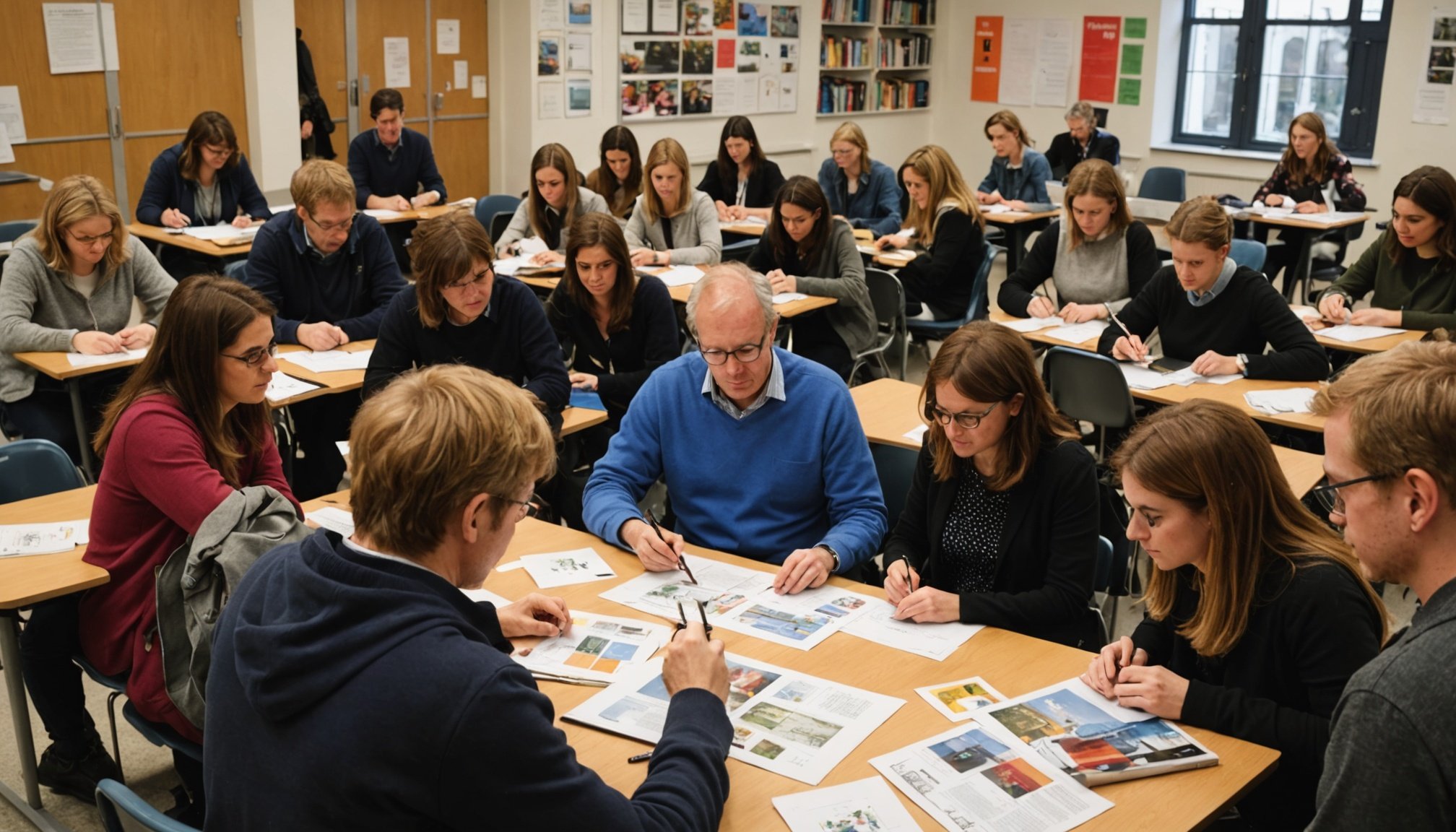Overview of Creative Cultures in UK Universities
Creative cultures within UK universities are characterized by a dynamic fusion of academic innovation and artistic expression. These cultures are crucial in higher education as they encourage a holistic development in students, driving them to think creatively, solve complex problems, and innovate across disciplines.
Currently, fostering creative cultures is gaining momentum, propelled by the increasing recognition of creativity’s role in academic and professional success. UK universities are focusing on nurturing these innovative environments, where students are motivated to explore uncharted territories of knowledge and creativity.
Also read : Boosting Green Mobility in the UK: How Electric Scooters are Leading the Way
However, establishing such cultures isn’t without its challenges. Universities often grapple with resource limitations, traditional academic structures, and sometimes a reluctance from faculty and administration to embrace more liberal approaches. Furthermore, aligning academic innovation with mainstream curriculums is a balancing act, demanding both visionary leadership and willingness to adapt.
To address these obstacles, universities are encouraged to implement policies and programs that promote creativity, provide platforms for open dialogue, and integrate interdisciplinary methodologies. By doing so, they can turn obstacles into opportunities, ultimately enhancing the educational experiences offered to students. The significance of creative cultures in higher education is vast, helping to shape well-rounded individuals ready to tackle the complexities of the modern world.
Additional reading : Fostering Continuous Growth in UK Schools: Proven Strategies for Cultivating a Vibrant Improvement Culture
Innovative Practices for Enhancing Creativity
Creative cultures thrive on innovative practices that serve to ignite and nurture genius. Universities are making strides by integrating creative enhancement into their core mission. The pursuit of improving creativity enhancement involves multifaceted approaches, from rejigging curriculum to piloting avant-garde teaching methods.
Case Studies of Successful Initiatives
Many UK universities exhibit successful innovative practices, offering a blueprint. For example, the collaboration between art and engineering departments has led to the development of creative products that wouldn’t have existed within a single discipline. Such initiatives illustrate the impact of cross-disciplinary work in creativity enhancement.
Roles of Faculty and Administration
Faculty and administration are pivotal in implementing best practices. Faculty can champion creativity by blending traditional lectures with project-based learning, encouraging a creative culture. Similarly, administrative leaders should ensure institutional support for such endeavors.
Importance of Student Engagement
Engaging students is vital. Offering hands-on projects that foster creativity ensures high engagement levels. Student-led innovation hubs also support this, providing real-world experience in powerfully creative environments. Together, these elements empower students, enhancing their education and preparing them for a creative future.
Collaboration as a Catalyst for Creativity
Collaboration is increasingly recognized as a catalyst in academic settings, unlocking novel avenues for creativity. Collaborative environments harness collective intelligence, bringing together diverse perspectives and skill sets. This synergy fosters interdisciplinary approaches, blending fields like science, arts, and technology to innovate and solve complex problems more efficiently.
For instance, a project merging the design expertise of arts students with the technical acumen of engineering students can yield groundbreaking results. These interdisciplinary projects often lead to creative outcomes unattainable within isolated disciplines. Examples abound, from technological innovations to social enterprise solutions, underscoring how teamwork transcends traditional boundaries.
To cultivate such collaboration among students and faculty, universities should constructively facilitate cross-departmental interaction. Creating shared spaces and flexible schedules for these interactions can stimulate engagement and creativity. Moreover, instituting multidisciplinary courses and joint projects can organically nurture teamwork, allowing individuals from various academic backgrounds to work cohesively towards common goals.
By embedding collaboration into the very fabric of academic culture, universities not only enhance creativity but also prepare students for the dynamic professional landscape. In sum, fostering collaboration is not merely advantageous—it is essential for nurturing vibrant, creative cultures within higher education.
The Role of Technology in Fostering Creativity
Technology plays a pivotal role in promoting creativity in education, acting as a catalyst through digital tools, platforms, and environments. As universities increasingly integrate technology into their curricula, students gain access to innovative tools that redefine how creativity is expressed and enhanced.
Utilizing Digital Tools and Platforms
Digital tools such as graphic design software, video editing suites, and coding platforms have revolutionised the creative process. By providing interactive and adaptive features, these tools cater to diverse learning styles, facilitating a more personalised approach to ^creative learning^. More importantly, they equip students with industry-relevant skills, ensuring readiness for the modern workforce.
Incorporating Virtual Learning Environments
Virtual learning environments (VLEs) significantly impact creativity by offering flexible and immersive educational experiences. They enable students to collaborate in virtual worlds, explore new concepts, and simulate real-world scenarios. This adaptability in learning supports individuals in experimenting and pushing creative boundaries.
Enhancing Creative Skills through Tech
Technology fosters the development of new creative competencies. Innovative tools enable users to prototype and iterate designs swiftly, encouraging experimental approaches. Moreover, tech fosters collaboration across disciplines, promoting a multidisciplinary mindset essential for contemporary innovation. By embracing technology, universities can drastically enhance their educational offerings, cultivating robust creative cultures.
Recommended Frameworks for Creative Development
Adopting effective creative development frameworks in universities is essential for nurturing academic innovation. Such frameworks provide strategic planning and alignment with institutional goals, ensuring that creative initiatives are both innovative and sustainable. They help universities create defined pathways for fostering creativity, addressing both faculty and student needs.
Frameworks can vary in structure, but successful ones often include:
-
Integration with Curriculum: Aligning creative initiatives with existing educational programs to ensure they complement rather than disrupt academic objectives.
-
Institutional Support and Resources: Providing the necessary resources and institutional backing ensures that creativity isn’t stifled by logistical barriers.
-
Regular Assessment and Feedback: Implementing assessment methods to evaluate the effectiveness of creative cultures helps identify areas for improvement and celebrate successes.
The importance of aligning these initiatives with the institution’s mission cannot be overstated. This strategic focus allows for a coherent approach to cultivating creativity, which can ultimately lead to enhanced educational offerings.
By establishing robust frameworks, universities create an environment where both students and faculty can thrive, pushing the boundaries of innovation and fostering a culture of ongoing creative development.
Potential Challenges in Fostering Creativity
Fostering creativity within universities faces numerous challenges in creativity that educators and administrators must navigate. One prevalent barrier is the entrenched nature of traditional academic structures. Faculty members accustomed to conventional teaching methods might resist the adoption of innovative practices, viewing them as a disruption rather than a benefit. Identifying such barriers to innovation is crucial.
Identifying Common Barriers
Common obstacles include limited resources, inflexible curriculums, and a prevailing focus on standardised testing. These factors can stifle creativity, making it difficult for academic innovation to flourish. Without adequate funding or institutional support, initiatives aimed at fostering creativity often stagnate.
Addressing Resistance to Change
To effectively foster creative cultures, universities must employ strategies to engage resistant faculty and administration. Encouraging open dialogue, providing ongoing professional development, and showcasing successful case studies can mitigate resistance. It’s vital for universities to cultivate an environment receptive to change.
Finding Solutions
Addressing these challenges requires solutions and best practices tailored to an institution’s unique context. Implementing pilot projects that demonstrate the tangible benefits of creative approaches can convert skeptics. Moreover, ensuring that faculty and students feel included and valued in the process fosters a supportive atmosphere for creativity. By tackling these hurdles head-on, universities can create vibrant and innovative environments.
Future Trends in Creative Cultures
The future of creativity within UK universities is set to be shaped by several emerging trends and developments. One critical aspect encompasses the rapid integration of technology in education, where innovative tools are revolutionizing creative processes. This evolution allows for a more interactive and personalized learning experience, enhancing student engagement and creativity.
Another trend includes the rise of interdisciplinary approaches. Universities increasingly recognize the value of teamwork, blending diverse fields such as arts, sciences, and technology to tackle complex issues. This move towards collaboration encourages students to think beyond traditional academic boundaries, promoting a culture of innovation and adaptability.
Furthermore, the emphasis on sustainability and social impact is reshaping how creativity is perceived and implemented. As global challenges become more pressing, academic institutions must foster creative cultures that prioritize solutions with real-world impact. This shift encourages students to develop projects that address societal needs, preparing them for a future where creativity serves a broader purpose.
In response to these trends, universities are adapting their curricula to reflect these changes, ensuring students are equipped to thrive in evolving academic environments. By embracing the future of creativity, UK universities position themselves as catalysts for transformative education, ready to lead in a rapidly changing world.








